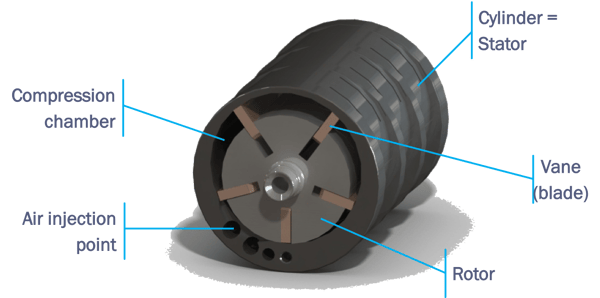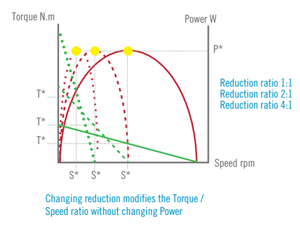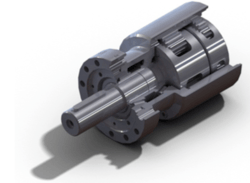Motor technical characteristics
18 avril 2016
Motor technical characteristicsBecause of their flexibility and versatility, pneumatic motors respond to a wide range of needs. It is therefore important to choose the right motor to achieve the desired results. This choice is an easy one to make once you know the basic principles!

Pneumatic gear motors with rotary vanes consist of a pneumatic part and a gear part.
 #1 Pneumatic part
#1 Pneumatic partIt is made up of a cylinder called a stator containing an eccentric rotor and closed at both ends by two flanges.
The space thus created between the stator and the rotor is crescent shaped. The rotor has slots within which the vanes will move freely.
While the rotor is in rotation, the centrifugal force presses the vanes on the internal surface of the stator thereby splitting the space into several chambers of different volumes.
Pressurized air (usually 4 to 6 bars) is injected into the pneumatic motor by the point of air injection. It enters the compression chamber which is thus pressurized. Each wall of this chamber will be subjected to a force proportional to its surface.
The walls of different surfaces defined by the vanes will be subject to different forces thereby driving the rotor in rotation.
The volume of the compression chamber will increase and the air within will expand. The next compression chamber is in turn submitted to pressure and the same phenomenon occurs, allowing for the constant rotation of the rotor.
This rotation motion then brings the chamber into exhaust position, releasing the air outside of the motor.
It is this succession of pressurization which enables motors operation.
To rotate the motor in the opposite direction, all one has to do is to differently position the point of air injection on the stator, the rotor is thus driven in the opposite direction.

Under a pressure of 6 bars, the rotor rotates at a speed of about 10 to 20,000 revolutions per minute (rpm) based on the motor. Planetary gears are used to adapt the movement to the desired application.
The gear will be selected in relation to the desired end use of the motor.
These gears allow for the reduction of speed and the increase of the torque output. With different types of pinions, a multitude of combinations is possible giving rise to a wide range of speed and torque.
It is possible to install several gear steps, 1 to 5 depending on the range of the pneumatic motor.
For a given air pressure, a compromise has to be made between the speed and the torque.
When there is no load applied to the motor, the torque is at 0 and the speed is therefore maximum.
When the applied load increases, the torque increases and the velocity decreases.
When the applied load exceeds the motors maximum torque, it causes the latter to “stall” this maximum torque is referred to as the stall torque.
Pneumatic motors can therefore be used with different settings (torque/speed) in many applications.
Most applications require low speeds and high torques, but it is possible to increase the speed by changing the gears as discussed above.
In addition to the almost endless capabilities in terms of settings, pneumatic motors are also highly adaptable to your working environment with the use of straight motors or with a right angle head and also remote control options.
If you want to know more about pneumatic motors, do not hesitate to download our handbook for free! Or request a free consultation in order to explain us your project !

+ 33 (0) 4 75 40 27 15
sales@modec.fr
ZI Sirius Quatre
80, allée René Higonnet
26760 Beaumont-lès-Valence, FRANCE
© Tous droits réservés - Modec - Création : ARKOD